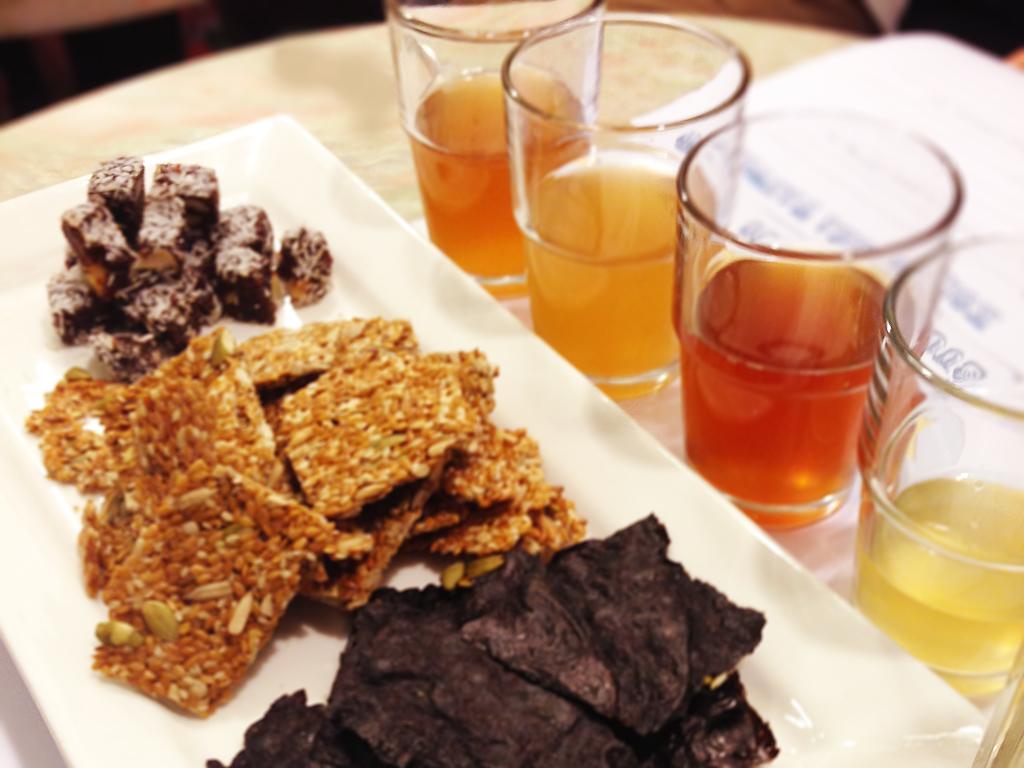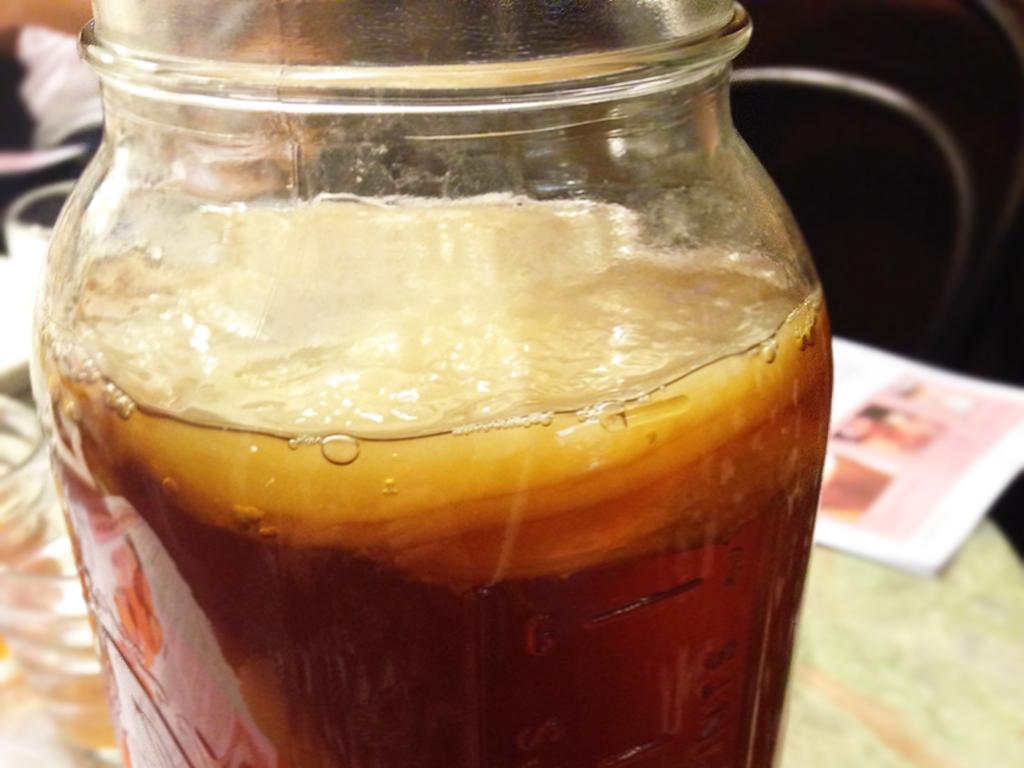5 Mins Read
Even if you only just occasionally glance at the news once every few weeks, the term probiotics must be somewhat familiar to you. And you probably also know that good gut health is kind of important. Probiotics = healthy digestive system. You also know that taking supplement pills is so passé and everyone and their mom is making their own fermented foods at home to ensure that their tummies are filled with the good kind of bacteria. Sauerkraut, kimchi, kefir, pickles– there is really no excuse to buy pre-made. After months of being store-bought kombucha addicts – the stuff is delicious! It’s basically soda for healthy grown ups!- we decided we could no longer be left out of the home brewing club and signed up for Chef Shima Shimizu’s Kombucha Making & Tasting Class. We share the best of what we learned below. Enjoy and happy fermenting!
Kom-bu..whaat?
- Kombucha is an effervescent fermented tea drink; it is a living food and contains beneficial bacteria in the form of gut-friendly probiotics.
- Most people consider kombucha to have originated in China. Some say a Korean physicist known as Kombu served the tea brew to the Japanese emperor and so its name was cemented.
- The term kombucha contains the word ‘cha, ‘ which means tea in many East Asian languages. In Japanese and Chinese, kombucha translates loosely as ‘mushroom tea.’
- Over the past 20 years, kombucha has experienced a renaissance, especially in the US where the movement against the industrialization of food
- If, like Green Queen, you are wondering where the first ever SCOBY came from, the answer is a disappointing ‘no clue whatsoever’ from anyone you ask.
The Tea Diaries
- Herbal teas don’t work when making kombucha. The bacteria, known as a SCOBY, needs the caffeine.
- Not all teas ferment equally. Some are easier to work with than others. Pu’er (known as Bo Lei in Cantonese), jasmine and black tea are easy. Green tea, white and Ooloong tea are on the difficult side- they don’t offer adequate nutrition for the SCOBY.
- Different teas will produce different kinds of kombucha- which is why a kombucha tasting night is very much a thing. The kombuchas will vary in bouquet, color, and flavor depending on the type of tea (as well as other variables like length of fermentation and sweetener used). Jasmine was by far our favorite!
- No flavored teas that may have extra ingredients. For example, Earl Grey won’t work as it has essence of Bergamot in it, which is an oil.
- For the same reason, organic tea should be used. Conventional teas will have pesticide and other toxic residues, which will affect the SCOBY.
SCOBY Dooby Doo
- SCOBY stands for Symbiotic Colony Of Bacteria and Yeast.
- The SCOBY want and needs only two things to make it happy: caffeine and sugar.
- The SCOBY ‘mother’ will produce at least one layer of ‘daughter, ‘ sometimes a few layers of daughters. The daughters SCOBYs will grow, the mother won’t.
- The surface of a health SCOBY should be fairly uniform and smooth. A bumpy, irregular SCOBY indicates it has gone moldy and you can no longer use it.
- A SCOBY can last indefinitely but discard it immediately if it gets moldy.
- Once you have successfully brewed your first batch, you can share the SCOBY wealth by passing on a piece of your SCOBY and a little liquid.
- If you are going away for a while, you can dehydrate your SCOBY to preserve it.
Fermentation Factoids
- Kombucha should be made in glass containers. Metal is a no-no as it is a reactive substance. Avoid metal not just in terms of the fermenting container but even when it comes to the extra equipment such as strainers, utensils, etc). Use plastic if you can’t get glass.
- There are two periods of fermentation when making kombucha: the first fermentation and the second fermentation.
- The first fermentation is done with plainly brewed tea, the SCOBY, some starter liquid and a sweetener. The liquid is allowed to breathe, the jar is covered with a coffee filter, a cheese cloth or even paper towel, tied down with a rubber band. Some people consider their kombucha ready to drink after the first fermentation.
- The second fermentation is when the effervescence (fizziness) happens. This is because during the second fermentation, the kombucha is not allowed to breathe- the glass container is covered with an airtight lid. Additional flavors are also added during the second fermentation.
- Kombucha can give add fruit pieces, dried fruit, fruit purees, essential oils, additional sweeteners- we tried one with maple syrup, which was lovely- it is totally up to you.
- Fermentation requires a dark, cool room with a temperature range of 20 to 30 °C; warmer temperatures accelerate the fermentation process.
- The longer the fermentation, the more acidic and the less sweet the kombucha.
- Typically, 5 to 7 days is considered a pretty short fermentation period and 2 to 3 weeks is considered fairly long.
Shima’s Special ‘Bucha Tips
- DONT feed it to kids: kombucha contains caffeine and alcohol- a very small amount of each, but still…
- Always label your jars with tea type, date you started the fermentation, sweetener used, whether it’s fermentation 1 or 2, extra flavors added, etc.
- Start with plain organic cane sugar for your first time making kombucha. It is the most consistent sweetener in terms of results. When you become for advanced, you can try out further varieties of sweeteners like coconut flower sugar, molasses or brown sugar.
- Always add a little of a previous kombucha batch to your new batch, as well as the SCOBY.
- Homemade kombucha cocktails make an excellent aperitif. Just add a shot of liquor and bam! You have yourself a Brooklyn-tastic drink that will knock the socks off your dinner guests!
Chef Shima Shimizu of Sesame Kitchen regularly teaches a host of classes, on various subjects such as the GAPS diet, fermented foods, raw vegan chocolate making, baby purees and more. She caters to all cooking levels, from beginners to advanced. You can order kombucha making starter kits from Sesame Kitchen; one kit includes a glass gallon jar, a SCOBY in kombucha liquid, pre-measured organic sugar, muslin tea bags, labels, Yisheng Organic loose tea (certified organic and fair trade) and instructions. They make a great gift!








